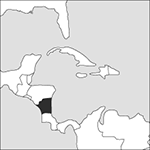
Source: MAPS IN MINUTES™ © RH Publications (1997)
Capital:
Managua
Area:
130,370 sq km (50,336 sq miles)
Population:
5,778,531 (2013 est)
Currency:
1 cordoba = 100 centavos
Religions:
Roman Catholic 58.5%; Protestant 23.2%
Ethnic Groups:
Mestizo 69.0%; White 17.0%; Black 9.0%; Amerindian 5.0%
Languages:
Spanish (official); Amerindian languages
International Organizations:
UN; OAS; Non-Aligned Movement; WTO
The largest country in Central America, bounded on the north by Honduras and on the south by Costa Rica.
Physical
Nicaragua has a south-western-facing coast on the Pacific Ocean and a longer, eastward-facing one on the Caribbean Sea, the Mosquito Coast. In the west are fertile plains and volcanic mountains.
Economy
The civil war of the 1980s devastated the economy, which also suffered from US attempts to enact a trade blockade and suspend foreign aid. Recovery was set back by severe damage caused by Hurricane Mitch in 1998; progress since has been slow, which has left Nicaragua one of the poorest American nations. Textiles and such agricultural products as coffee, beef, sugar, peanuts, and tobacco form nearly half of Nicaragua’s exports. Gold has been mined for over a century in Nicaragua, but in recent years, international mining companies have invested in new mines, and gold is now one of the country’s major exports. The principal industries include food processing, chemicals, machinery and metal products, and clothing.
History
The first inhabitants of Nicaragua were Indians from South America who settled on the coast. From the 10th century ad peoples from Mexico began to immigrate into the region. The first Spanish colonization was undertaken by Francisco Hernándes de Córdoba, who founded the towns of Granada on Lake Nicaragua and León on Lake Managua in 1524. One of the main Indian tribes converted to Christianity, which enabled the Spanish to take control of the area with ease. Administratively part of the viceroyalty of New Spain and the captaincy-general of Guatemala, Nicaragua grew slowly. It depended upon agriculture, which developed substantially in the 18th century. The country achieved its independence from Spain in 1821. Nicaragua was briefly annexed into the Mexican empire of Agustín de Iturbide, and with the collapse of that experiment formed part of the United Province of Central America until becoming independent again in 1838. In 1848 the British seized San Juan del Norte, known as the Mosquito Coast, after a tribe of American Indians, the Miskito. In 1855 a US adventurer, William Walker, seized control of the country and made himself President (1856–57). His ousting helped unite the country, which made peace with Britain and recognized a separate Mosquito kingdom. The 20th century opened with the country under the vigorous control of the dictator José Santos Zelaya, who extended Nicaraguan authority over the Mosquito kingdom. The USA, apprehensive of his financial dealings with Britain, supported the revolution which overthrew him in 1907. The US presence, including two occupations by the marines, dominated the country until 1933. In 1937 Nicaragua fell under the control of Anastasio Somoza, who ruled until his assassination in 1956. He was succeeded by his son Luis (1957–63), and then by the latter’s brother, General Anastasio Debayle Somoza (1967–72, 1974–79). In 1962 a guerrilla group, the Sandinista National Liberation Front, was formed. It gained increasing support from the landless peasantry and engaged in numerous clashes with the National Guard, ending in civil war (1976–79). Once established as a ruling party, the Sandinistas, led by Daniel Ortega, expropriated large estates for landless peasants and nationalized mines and forests. The dispossessed and exiled owners of the estates then organized opposition to the regime, recruiting a ‘Contra’ rebel army, funded and organized by the CIA. The Reagan administration was seriously embarrassed by exposure in 1986–87 of illegal diversion of money to the Contras from US sale of arms to Iran. When President Bush took office in 1989 direct military funding to the Contras ended. Elections were held in 1990 with opposition groups generously funded by the USA. The Sandinistas lost to a coalition group led by Violeta Chamorro. Although she succeeded in winning a $300 million loan from the USA, severe economic recession followed. In 1992 there were violent clashes between re-armed Contras and Sandinista ‘re-Compas’. A ceasefire agreement was reached in 1994. In 1996 Chamorro resigned, and the conservative Arnaldo Alemán defeated Ortega in presidential elections. Enrique Bolaños became President in 2002. Ortega was returned to the Presidency in 2007 and was re-elected in 2011 and 2016.
- Kekulé structure
- Kekulé von Stradonitz, Friedrich August
- Kellner eyepiece
- Kellner, Karl
- Kellogg-Briand Pact (1928)
- kelly
- Kelly, James McNeal (1964– )
- Kelly, Mark Edward (1964– )
- Kelly, Ned (1855–80)
- Kelly, Petra (1947–92)
- Kelly, Scott Joseph (1964– )
- kelp
- Kelsen, Hans (1881–1973)
- kelvin
- Kelvin balance
- Kelvin contacts
- Kelvin double bridge
- Kelvin effect
- Kelvin, Lord
- Kelvin, Lord (1824–1907)
- Kelvin scale
- kelvin scale
- kelvin(symbol: K)
- Kelvin, William Thomson
- Kelvin–Helmholtz contraction